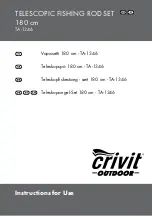
T H E W O R L D P O W E R I N A N C H O R I N G S Y S T E M S
21 July 2011
www.muir.com.au
9
OPERATING INSTRUCTIONS
Manually Releasing chain:
To release the anchor rode, place the handle into the clutch drive bi-square as
shown in the diagram at the bottom of the page and turn
anti-clockwise
to release the clutch brake. Let the
anchor fall and control the run of the chain by tightening handle
clockwise
using the clutch mechanism as
a brake.
Anchoring:
When laying at anchor, use a chain stopper, nylon/chain bridle or snubber line to prevent
snatching and direct loading on the windlass main shaft. Never use the windlass as a mooring bollard.
Retrieving Chain:
Before operating the windlass tighten the clutch with the handle in a
clockwise
direction,
then remove the handle. If anchor retrieval is impaired by high wind, heavy seas or the anchor is buried hard,
ease the load by motoring slowly forward into the wind with a chain stopping device in place. This way, the
anchor is driven out by the engine, otherwise the gearbox or shaft can be damaged.
Rope hauling on the Capstan (VRC models only):
The capstan can be operated independently of the gypsy.
Secure the anchor rode (via chain lock, Gypsy lock or Snubber) then release the clutch. The capstan can
then be operated using the manual handle or by operating the windlass motor.
Electric / Hydraulic operation:
Releasing and retrieving the anchor rode is identical when operating an
electric or hydraulic windlass. Always keep well clear of the windlass when releasing or retrieving chain and
anchor. Keep fingers, hair and clothing well clear when the windlass is in operation.
Auto Anchor Launching:
If the anchor roller can be positioned so that the anchor falls as soon as the windlass
is reversed, the whole operation can then be carried out remotely. Remote switching controls are self
centering and stop the windlass when the switch is released. Mark the anchor end of the chain at 2 and 5
metre (6.5’ & 16.5’) intervals to enable the operator to judge when the anchor is almost up. For the last few
metres of chain retrieval, decrease retrieval speed by letting go of the switch, rather than waiting for the
anchor to fly up over the roller and bang tight, as this will put excessive load onto the bow roller, windlass
and foredeck.
SERVICING
Rinsing all deck gear with fresh water after every excursion ensures that salt deposits and corrosion are kept
to a minimum. We recommend the windlasses of Pleasure Vessels are stripped yearly and all moving parts
cleaned and greased with an appropriate marine grade grease. Servicing should be carried out more
frequently with increased usage (e.g. in the case of Work and Charter Vessels).
Do not use soap based
grease.
The geardrive is filled and sealed at factory with long life synthetic oil that does not require replacement for
the life of the geardrive.
Gradually loosen
to release the line
manually.
Tighten to handle to slow
the rate of the outgoing
line. Fully tighten prior to
retrieving the anchor
under power.
Summary of Contents for Easy Weigh Series
Page 13: ......
Page 15: ......
Page 16: ......
Page 17: ......
Page 18: ......
Page 19: ......
Page 20: ......
Page 21: ......
Page 22: ......
Page 23: ......
Page 24: ......
Page 25: ...WINDLASSES AUSTRALIA DNV Certification Pty Ltd JAS ANZ ...
Page 26: ......
Page 27: ......
Page 28: ......
Page 29: ......










































